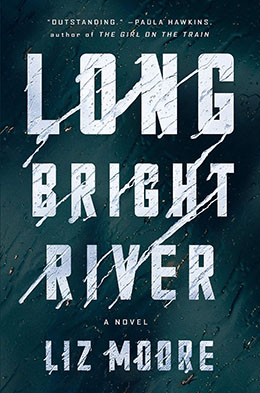While probably not intentional, it is fitting that there is a reference to length in the title of Liz Moore’s latest work, Long Bright River. This is an epic book in all meanings of the word. Clocking in at just about 500 densely-packed pages, the novel is a serious commitment for readers and the story held within feels so much larger than the narrow focus on display. This is because Liz Moore is confronting one of the largest – and deadliest – societal ills of modern times: the opioid crisis plaguing both cities and suburban settings.
Anyone who has read Liz Moore before will know that she is hardly going to tackle this epidemic from the standard angles. This is an author skilled at creating relatable characters and then forcing readers to confront them head-on, unable to look away or feign ignorance as to their plights. In Long Bright River, the focus is on two sisters and the ever-diverging paths life has led them, forced them, down.
Mickey is a single mother working for the Philadelphia police department. When she and her newest partner locate the body of a young female prostitute/addict, Mickey can’t help but think of her sister Kacey. Kacey has been living on the streets for some time now, estranged from her family, continually making poor decisions and moving aimlessly toward a disasterous future.

Told in alternating timelines – NOW and THEN – Long Bright River’s narrative is likely to split readers. Some will prefer the present day investigation into a series of deaths and how that leads Mickey on a journey to find and hopefully reconnect with the sister who used to be her closest confidant. While others will prefer the flashbacks that outline the girls’ youth, their domestic situation, and the how and why of their eventual separation. Both storylines are well executed and the interplay between them is skillfully wrought. It is vital to connect with the sisters in the past in order to feel the necessary empathy for them in their current situation, but Liz Moore certainly knows how to draw readers into forging a relationship with these fictional characters, so readers who stick with the earlier meanders of the novel will be rewarded with an emotional wallop by the end.
Long Bright River is hardly a light read, but I suspect anyone interested in the plotline will understand that. Addiction is something that virtually everyone has experienced in some form or fashion, so how readers interact with this novel will depend on their direction into it. It is clear that Liz Moore did her research on the opioid crisis and she intimately knows the Philadelphia landscape. One gets the sense that the novel could be used as a roadmap around the city – albeit one that fails to focus on the touristy side of things. Fans of noir fiction, who might be hesitant about a novel featuring two female leads, should immediately brush off this preconceived bias and allow Liz Moore to lead them down some of the darkest streets – both physical and psychological – one will ever find in crime fiction.
It is only January, but that will not stop Liz Moore’s Long Bright River from finding a comfortable home on Best of 2020 lists moving forward.
BUY LINKS: Long Bright River by Liz Moore
_______________________________________________________________________
Disclaimer: A print galley of this title was obtained at ALA. No review was promised and the above is an unbiased review of the novel.

I discovered you on Jungle Red Writers and really enjoyed this book review. Would like to continue reading them.